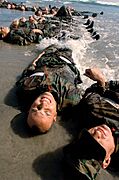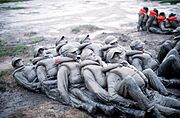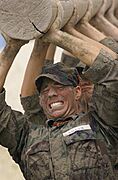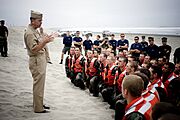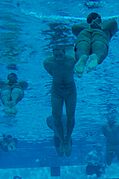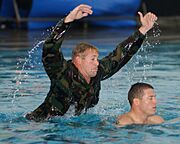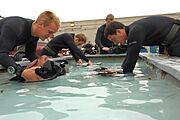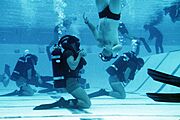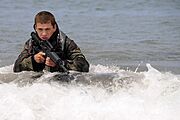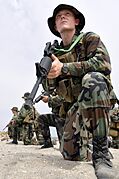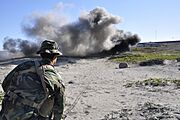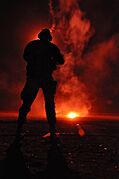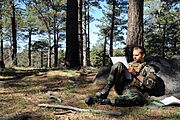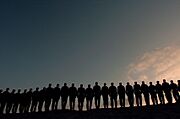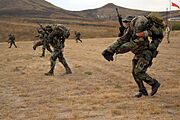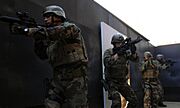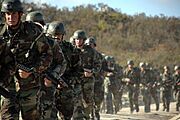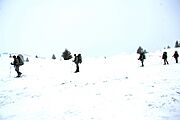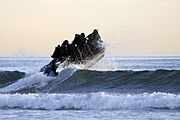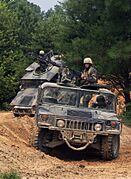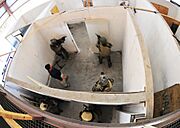United States Navy SEAL selection and training facts for kids

Becoming a Navy SEAL is one of the toughest challenges in the U.S. Navy. These elite service members are part of the Sea, Air, and Land Teams. They go through more than a year of intense training to earn their special title. This training includes several schools and programs.
All future SEALs must complete a 24-week course called Basic Underwater Demolition/SEAL (BUD/S) school. After that, they attend a basic parachutist course. The final step is the 26-week SEAL Qualification Training program. Some SEALs also take a six-month Special Operations Tactical Medic course. This course teaches them advanced medical skills. Once they join an operational team, SEALs train for about 18 months before their first six-month mission.
Contents
| Training Step | Success Rate | Overall Rate |
|---|---|---|
| Signed up | 79% | 79% |
| Finished basic training | 58% | 45% |
| Completed SEAL pre-indoctrination | 90% | 41% |
| Completed SEAL indoctrination | 85% | 35% |
| Completed BUD/S Phase 1 | 33% | 11% |
| Completed BUD/S Phase 2 | 87% | 10% |
| Completed BUD/S Phase 3 | 96% | 10% |
| Graduated Airborne School | 100% | 10% |
| Completed SEAL Qualification Training | 99% | 9.5% |
Joining the Navy SEALs is completely voluntary. Both officers and enlisted sailors train together. To volunteer, you must be a US citizen. You also need to be between 18 and 29 years old. Sometimes, people from allied countries can also train at BUD/S. Waivers are possible for 17-year-olds with parent permission. They are also considered for 29 and 30-year-olds in special cases.
Academically, all applicants need a high school education or its equivalent. They must score at least 220 on the ASVAB test. Being good at English is also a must. For health, vision must be at least 20/70, correctable to 20/25. Candidates must pass the SEAL Physical Screening Test. They also need to have a good moral character. This means having a clean record without serious rule-breaking.
Women in SEAL Training
Since December 2015, women have been able to try out for SEAL training. They must meet the exact same tough standards as men. This policy ensures everyone faces the same challenges.
In 2019, the first woman successfully completed the screening to enter BUD/S. She was then assigned to a different unit, which was her first choice. A historic moment happened on July 15, 2021. The first woman became a Special Warfare Combatant-craft Crewman (SWCC). She was one of 17 graduates from her class.
The Physical Screening Test
To get into BUD/S, candidates must pass the SEAL Physical Screening Test (PST). It's important to do much better than the minimum scores. The test includes:
- A 500-yard swim using breaststroke or combat sidestroke in under 12:30 minutes. A competitive time is 9:00 minutes or less.
- At least 50 push-ups in 2 minutes. A competitive count is 90 or more.
- At least 50 sit-ups in 2 minutes. A competitive count is 90 or more.
- At least 10 pull-ups from a dead hang. A competitive count is 18 or more.
- A 1.5-mile run in shorts and sneakers in under 10:30 minutes. A competitive time is 9:30 minutes or less.
The training journey begins at the Naval Special Warfare Preparatory School. This school is located in San Diego, CA. Here, future SEALs get ready for the extreme physical demands. They learn what it takes to even attempt SEAL training.
The school starts with the initial Physical Screening Test. It ends with a much harder Modified Physical Screening Test. This final test requires at least 70 push-ups in 2 minutes. It also includes a four-mile run in 31 minutes. Plus, there's a 1,000-meter swim with fins in 20 minutes. The main goal is to boost candidates' fitness. This ensures they are ready for the next big step: BUD/S Training. Those who cannot pass the final test are reassigned to other jobs in the Navy.
Basic Underwater Demolition/SEAL (BUD/S) Training (24 weeks)
BUD/S is a 24-week training course. It helps SEAL candidates build mental and physical strength. It also develops their leadership skills. Each phase of BUD/S has timed physical tests. The time limits get tougher every week. BUD/S starts with a two-week orientation. Then, it has three main phases. These phases cover physical conditioning (seven weeks), combat diving (seven weeks), and land warfare (seven weeks). Both officers and enlisted personnel go through the same program. This training is designed to test their endurance, leadership, and ability to work as a team. It is incredibly demanding, and many candidates choose to leave the program.
BUD/S Orientation (2 weeks)
BUD/S Orientation is a two-week course. It introduces candidates to the Naval Special Warfare Center. It also shows them what the BUD/S lifestyle is like. Navy SEAL instructors teach candidates about BUD/S physical training. They also learn about the obstacle course, swimming, and other unique training aspects. This part of training helps candidates prepare for the very first day of First Phase.
Phase 1: Physical Conditioning (7 weeks)
The first phase of BUD/S tests candidates' physical fitness. It also checks their skills in water, teamwork, and mental toughness.
This phase includes daily running, swimming, and exercises. It gets harder as the weeks go on. Candidates also work in "boat crews" of six or seven people. They use a small inflatable boat (IBS). They must paddle it from the shore, through ocean waves, and back. Candidates do weekly four-mile timed runs. They also complete timed obstacle courses. They swim up to two miles in the ocean with fins. They also learn how to handle small boats. Candidates who consistently miss the time goals for runs and swims are removed from training.
The first three weeks prepare candidates for the fourth week, known as "Hell Week." During Hell Week, candidates train continuously for five and a half days. Each candidate sleeps at most four hours during the entire week. They run more than 200 miles. They also do physical training for over 20 hours each day. Candidates are given regular meals. The remaining three weeks involve learning how to survey water areas. They also learn to create hydrographic charts. All this happens while still doing timed runs and swim tests.
Because of its extreme challenges, many candidates question their decision during First Phase. A significant number decide to "Drop on Request" (DOR). The tradition of DOR involves dropping one's helmet liner. Then, they ring a brass ship's bell three times.
In February 2022, after completing "Hell Week," some candidates experienced serious health issues due to the extreme physical demands. Sadly, one sailor passed away, and another needed hospital care. This shows how incredibly tough and risky this part of the training is.
Phase 2: Combat Diving (7 weeks)
The diving phase of BUD/S training makes SEAL candidates expert combat swimmers. During this time, physical training continues and becomes even more intense. This second phase focuses on dive physics, underwater skills, and combat SCUBA. Candidates learn two types of SCUBA gear: open circuit (using compressed air) and closed circuit. They also get basic dive medicine and medical skills training.
A lot of emphasis is placed on long-distance underwater dives. The goal is to train students to become basic combat divers. They use swimming and diving to travel from their starting point to their mission objective. This is what makes SEALs different from other US Special Operations Forces. By the end of Second Phase, candidates must complete a timed 2-mile swim with fins in 80 minutes. They also do a 4-mile run with boots in 31 minutes. Longer swims of 3.5 and 5.5 miles are also required.
Successful Second Phase candidates are very comfortable in the water. They can perform well in stressful and often difficult environments. Candidates who are not completely at ease in the water often struggle to succeed.
Phase 3: Land Warfare (7 weeks)
The land warfare phase teaches the class basic weapons and demolitions. They also learn land navigation, patrolling, and rappelling. Marksmanship, infantry tactics, and small-unit tactics are also key skills. During the third phase, the class learns to gather and use information for their missions. There is more classroom work. This teaches map reading, compass use, land navigation, and basic weapon skills. These skills help the class go from beginners to being comfortable in the field. Most of this training is new, and the learning pace gets faster.
For the final five weeks of training, the class moves offshore. They go about 60 miles from Coronado to San Clemente Island. On the island, the class practices all the skills they learned in the third phase. The days become longer and more work-intensive. This is designed to be like the long hours spent on real missions. Many students find this one of the hardest parts of training. Training happens seven days a week, with very little sleep. All this happens while handling live explosives and ammunition. Instructors constantly push candidates to their limits. By the end of the Third Phase, candidates must complete a timed 2-mile ocean swim with fins in 75 minutes. They also do a 4-mile timed run with boots in 30 minutes. A 14-mile run is also part of the final tests.
- BUD/S Training
-
First Phase Team focused physical training with telephone pole sized logs is common (largest is nicknamed “Old Misery”). This log exercise is an inheritance from the British Commando training used during the formation in Britain of the U. S. Navy’s UDTs during World War II. These were the precursors of the SEAL teams.
-
First Phase Then-Chief of Naval Operations (CNO) Adm. Mike Mullen addresses the remaining trainees of Class 266 at the end of "Hell Week."
-
Third Phase A trainee carries out an over the beach exercise on San Clemente Island.
-
Third Phase A student detonates an explosive charge on San Clemente Island as part of his basic demolitions training.
-
Third Phase A trainee is illuminated by a flare during a live-fire exercise on San Clemente Island.
-
Third Phase A student plots coordinates on his map during an individual land navigation exercise in Mount Laguna.
Parachute Jump School (3 weeks)
After successfully completing BUD/S, SEAL candidates move on to parachute jump school. This three-week program takes place at Tactical Air Operations in San Diego, California. It is a very structured course. Expert instructors teach candidates to become safe and skilled free-fall jumpers quickly.
To finish the course, candidates must pass several jump stages. They start with basic static line jumps. Then they move to accelerated free fall. Finally, they learn to jump with combat equipment. This includes completing night descents from at least 9,500 feet.
SEAL Qualification Training (SQT) (26 weeks)
SEAL Qualification Training (SQT) is a 26-week course. It takes students from basic special warfare skills to advanced tactical training. SQT gives students the key tactical knowledge they need to join a SEAL Platoon.
This training covers many areas. These include weapons training and close-quarters combat. Students also learn small unit tactics and land navigation. Demolitions, unarmed combat, and cold weather training in Kodiak, Alaska are also part of the course. Medical skills and maritime operations are taught as well. Before graduating, students also attend Survival, Evasion, Resistance and Escape Training (SERE Training).
Graduation from SQT is a big moment. Students are awarded the Navy SEAL Trident. They also receive a special job code (NEC 5326 Combatant Swimmer (SEAL) or 1130 Special Warfare (SEAL) Officer). New SEALs are immediately assigned to a SEAL Team. These teams are in Coronado, CA, or Little Creek, VA. They then begin advanced training for their first mission.
- SEAL Qualification Training
-
Students simulating moving comrades during a live fire exercise on Camp Pendleton.
SEAL Troop (TRP) Training: Preparing for Missions
After SQT, new SEALs receive orders to a SEAL Team. They are assigned to a Troop (TRP) and a Platoon (PLT). New operators join their Platoon wherever it is in its mission cycle. The normal preparation for a mission, or "workup," lasts 12 to 18 months. This cycle is divided into three phases.
Individual Specialty Training
Phase one of a work-up is Individual Specialty Training. This phase lasts 6 months. During this time, individual operators attend various schools and courses. These schools help them get the special skills and qualifications needed. These skills allow the entire platoon to work as an effective combat team. Depending on the team's needs, operators might learn skills like:
- Becoming a SEAL Sniper.
- Advanced Close Quarter Combat, including how to breach barriers.
- Secret entry methods, like bypassing locks.
- Special Operations Combat Medic skills.
- Advanced Special Operations techniques.
- Technical Surveillance Operations.
- Advanced Driving Skills for defensive or protective situations.
- Climbing and Rope Skills.
- Advanced Air Operations, like becoming a Jumpmaster.
- Diving Supervisor or Diving Maintenance-Repair.
- Range Safety Officer.
- Advanced Demolition.
- High Threat Protective Security for important people.
- Instructor School to teach others.
- Operating Unmanned Aerial Vehicles (drones).
- Learning a new language at a Language School.
- Professional Military Education for joint special operations.
Unit Level Training
Phase two of a work-up is called Unit Level Training (ULT). This is a 6-month period. During ULT, the Troop and Platoon train in their main mission areas. They practice small unit tactics and land warfare. Close quarters combat and urban warfare are also key. They learn hostile maritime interdiction, like boarding ships. Combat swimming, long-range target skills, and air/surface operations are also covered. Special reconnaissance is another important skill they develop.
Task Group Level Training
Phase three of a work-up is Task Group Level Training. This is the final 6-month period. During this time, a troop conducts advanced training with supporting teams. These include Special Boat Teams (SWCC), Intelligence Teams, and Communications Teams. Medical Teams, Explosive Ordnance Disposal (EOD), and Interpreters also join. A final Certification Exercise (CERTEX) is held with the entire SEAL Squadron. This ensures all Troop operations work together smoothly. After CERTEX, a SEAL Team becomes a SEAL Squadron. They are then certified and ready for deployment.
Once certified, a SEAL Team/Squadron deploys to a mission area. They might become a Special Operations Task Force (SOTF). They could also join a Joint Task Force (JTF) to support national goals. Once assigned, the Troops get an Area of Operations (AOR). They work as a whole Troop or split into smaller groups for missions. A SEAL Team/Squadron deployment usually lasts about 6 months. This makes the entire training and deployment cycle 12 to 24 months long.
- SEAL Troop (TRP) Training
-
SEALs being hoisted into a CV-22 Osprey from the Air Force's 8th Special Operations Squadron during a joint training exercise.
See also
- Naval Special Warfare Advanced Training Command
- SEAL Team Six § Recruitment, selection and training
- Naval Special Warfare Center
- Underwater Demolition Team
- United States Navy SEALs
In other countries
- Commandos Marine § Recruitment and training
- Special Boat Service § Recruitment and training
- Kommando Spezialkräfte Marine § Conditions for entry
- MARCOS § Selection and Training



